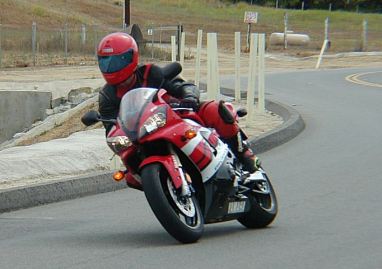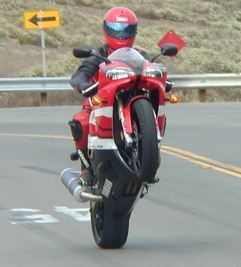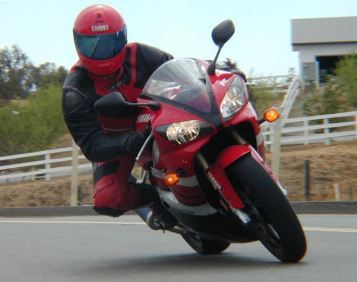
I recently took delivery of a 2000 Yamaha R1 for an extended test. This is the first of at least two reports of my experience with Yamaha’s already legendary sportbike.
To put this test in context, I have already ridden Honda’s 2000 929RR (at the race track only) and Suzuki’s 2000 GSXR750 (on the street, only).
The first thing you notice about the 2000 Yamaha R1 is its awesome motor. I can’t even tell you where the powerband begins, because I have never lugged the bike low enough to experience a lack of power. Suffice it to say that the R1 pulls, very strongly, from almost no revs. This is remarkable for a sportbike.
The broad spread of power results primarily from two factors, including (1) the large displacement (1000cc), and (2) Yamaha’s patented EXUP valve in its exhaust system (which varies back pressure depending on RPM — effectively broadening the powerband and improving low end power and torque).

The power is not intimidating, however, unless you want it to be. By this I mean the power comes on progressively and smoothly. You simply dial on as much as you want. Above 7,000 rpm, if you want to hold the throttle on in the lower gears, the power will intimidate you if you are not used to it. In first gear, the front end will lift whether you want it to or not under these circumstances (throttle wide open). Be careful.
With a six-speed transmission, you have more than enough gears given the broad spread of power provided by the R1, and gear selection is frequently an option, rather than a necessity. No other sportbike I have ridden (short of Suzuki’s Hayabusa, which is not a direct competitor of the R1 — it is too heavy) has power nearly this broad or pulls nearly this hard from low rpms.
The progressive power builds to a hard rush above 7500 rpm. The low rpm grunt doesn’t sacrifice a strong pull on top. In short, the motor is more than you will need under almost any street circumstance, and, treated with proper respect, is very entertaining and very rewarding to use.

The R1, due to its chassis design (including its extra long swingarm) places quite a bit of weight over the front wheel. This translates into impressive stability, both in a straight line and through sweeping turns (where the R1 holds its line extremely well). This also gives the R1 a somewhat heavier turning feel than you would expect for the dry weight of the bike (advertised as 385 pounds). This “planted” feeling is reassuring given the power output, but does take some getting used to if you are coming off a 600 or even Honda’s new CBR929RR.
Ultimately, the “heavy front end” feeling imparted by the R1 is something I appreciated. Although a Ducati 916/996, for instance, is a very heavy turning bike compared to some of the lighter sportbikes around, and is a much heavier turning bike than the R1, like the Ducati, the tradeoff with the Yamaha is an incredible sense of stability once leaned over in the turn. The bike tracks like a freight train, and mid-corner bumps hardly disturb it.
This also means the R1 responds best to aggressive riding. Not that you should ride this bike aggressively on the street. The bike is, by its very nature, an aggressive machine yet must be respected. What I mean by aggressive riding is turning the bike aggressively into corners. The R1 doesn’t “fall in” — it needs to be pushed in by the rider. In addition to greater stability mid-turn, this means that the rider feels more in control of the machine.
I plan to ride the R1 quite a bit more during the next few weeks and I will post another report at that time. These are my initial impressions, however.





